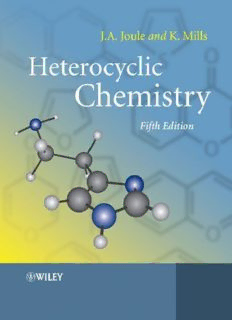
Heterocyclic Chemistry PDF
Preview Heterocyclic Chemistry
Contents Preface to the Fifth Edition Biography Definitions of Abbreviations 1 Heterocyclic Nomenclature 2 Structures and Spectroscopic Properties of Aromatic Heterocycles 2.1 Carbocyclic Aromatic Systems 2.2 Structure of Six-Membered Heteroaromatic Systems 2.3 Structure of Five-Membered Heteroaromatic Systems5 2.4 Structures of Bicyclic Heteroaromatic Compounds 2.5 Tautomerism in Heterocyclic Systems6,7 2.6 Mesoionic Systems8 2.7 Some Spectroscopic Properties of Some Heteroaromatic Systems References 3 Substitutions of Aromatic Heterocycles 3.1 Electrophilic Addition at Nitrogen 3.2 Electrophilic Substitution at Carbon6 3.3 Nucleophilic Substitution at Carbon33 3.4 Radical Substitution at Carbon45 3.5 Deprotonation of N-Hydrogen59 3.6 Oxidation and Reduction60 of Heterocyclic Rings 3.7 ortho-Quinodimethanes in Heterocyclic Compound Synthesis61 References 4 Organometallic Heterocyclic Chemistry 4.1 Preparation and Reactions of Organometallic Compounds 4.2 Transition Metal-Catalysed Reactions108 References 5 Methods in Heterocyclic Chemistry 5.1 Solid-Phase Reactions1 and Related Methods 5.2 Microwave Heating23 5.3 Flow Reactors 5.4 Hazards: Explosions References 6 Ring Synthesis of Aromatic Heterocycles 6.1 Reaction Types Most Frequently Used in Heterocyclic Ring Synthesis 6.2 Typical Reactant Combinations 6.3 Summary 6.4 Electrocyclic Processes in Heterocyclic Ring Synthesis 6.5 Nitrenes in Heterocyclic Ring Synthesis8 6.6 Palladium Catalysis in the Synthesis of Benzo-Fused Heterocycles References 7 Typical Reactivity of Pyridines, Quinolines and Isoquinolines 8 Pyridines: Reactions and Synthesis 8.1 Reactions with Electrophilic Reagents 8.2 Reactions with Oxidising Agents 8.3 Reactions with Nucleophilic Reagents 8.4 Metallation and Reactions of C-Metallated-Pyridines 8.5 Reactions with Radicals; Reactions of Pyridyl Radicals 8.6 Reactions with Reducing Agents 8.7 Electrocyclic Reactions (Ground State) 8.8 Photochemical Reactions 8.9 Oxy-and Amino-Pyridines 8.10 Alkyl-Pyridines 8.11 Pyridine Aldehydes, Ketones, Carboxylic Acids and Esters 8.12 Quaternary Pyridinium Salts 8.13 Pyridine N-oxides245 8.14 Synthesis of Pyridines Exercises References 9 Quinolines and Isoquinolines: Reactions and Synthesis 9.1 Reactions with Electrophilic Reagents 9.2 Reactions with Oxidising Agents 9.3 Reactions with Nucleophilic Reagents 9.4 Metallation and Reactions of C-Metallated Quinolines and Isoquinolines 9.5 Reactions with Radicals 9.6 Reactions with Reducing Agents 9.7 Electrocyclic Reactions (Ground State) 9.8 Photochemical Reactions 9.9 Oxy-Quinolines and Oxy-Isoquinolines 9.10 Amino-Quinolines and Amino-Isoquinolines 9.11 Alkyl-Quinolines and Alkyl-Isoquinolines 9.12 Quinoline and Isoquinoline Carboxylic Acids and Esters 9.13 Quaternary Quinolinium and Isoquinolinium Salts 9.14 Quinoline and Isoquinoline N-Oxides 9.15 Synthesis of Quinolines and Isoquinolines Exercises References 10 Typical Reactivity of Pyrylium and Benzopyrylium Ions, Pyrones and Benzopyrones 11 Pyryliums, 2-and 4-Pyrones: Reactions and Synthesis 11.1 Reactions of Pyrylium Cations4,5 11.2 2-Pyrones and 4-Pyrones (2H-Pyran-2-ones and 4.H-Pyran- 4-ones; α-and γ-Pyrones) 11.3 Synthesis of Pyryliums1,7a 11.4 Synthesis of 2-Pyrones 11.5 Synthesis of 4-Pyrones Exercises References 12 Benzopyryliums and Benzopyrones: Reactions and Synthesis 12.1 Reactions of Benzopyryliums 12.2 Benzopyrones (Chromones, Coumarins and Isocoumarins) 12.3 Synthesis of Benzopyryliums, Chromones, Coumarins and Isocoumarins Exercises References 13 Typical Reactivity of the Diazine: Pyridazine, Pyrimidine and Pyrazine 14 The Diazines: Pyridazine, Pyrimidine, and Pyrazine: Reactions and Synthesis 14.1 Reactions with Electrophilic Reagents 14.2 Reactions with Oxidising Agents 14.3 Reactions with Nucleophilic Reagents 14.4 Metallation and Reactions of C-Metallated Diazines50 14.5 Reactions with Reducing Agents 14.6 Reactions with Radicals 14.7 Electrocyclic Reactions 14.8 Diazine N-Oxides79 14.9 Oxy-Diazines 14.10 Amino-Diazines 14.11 Alkyl-Diazines 14.12 Quaternary Diazinium Salts 14.13 Synthesis of Diazines 14.14 Pteridines Exercises References 15 Typical Reactivity of Pyrroles, Furans and Thiophenes 16 Pyrroles: Reactions and Synthesis 16.1 Reactions with Electrophilic Reagents5 16.2 Reactions with Oxidising Agents65 16.3 Reactions with Nucleophilic Reagents 16.4 Reactions with Bases 16.5 C-Metallation and Reactions of C-Metallated Pyrroles 16.6 Reactions with Radicals 16.7 Reactions with Reducing Agents 16.8 Electrocyclic Reactions (Ground State) 16.9 Reactions with Carbenes and Carbenoids 16.10 Photochemical Reactions120 16.11 Pyrryl-C-X Compounds 16.12 Pyrrole Aldehydes and Ketones 16.13 Pyrrole Carboxylic Acids 16.14 Pyrrole Carboxylic Acid Esters 16.15 Oxy-and Amino-Pyrroles 16.16 Synthesis of Pyrroles5,140 Exercises References 17 Thiophenes: Reactions and Synthesis 17.1 Reactions with Electrophilic Reagents 17.2 Reactions with Oxidising Agents 17.3 Reactions with Nucleophilic Reagents 17.4 Metallation and Reactions of C-Metallated Thiophenes 17.5 Reactions with Radicals 17.6 Reactions with Reducing Agents 17.7 Electrocyclic Reactions (Ground State)118 17.8 Photochemical Reactions 17.9 Thiophene-C–X Compounds: Thenyl Derivatives 17.10 Thiophene Aldehydes and Ketones, and Carboxylic Acids and Esters 17.11 Oxy-and Amino-Thiophenes 17.12 Synthesis of Thiophenes146 Exercises References 18 Furans: Reactions and Synthesis 18.1 Reactions with Electrophilic Reagents 18.2 Reactions with Oxidising Agents 18.3 Reactions with Nucleophilic Reagents 18.4 Metallation and Reactions of C-Metallated Furans 18.5 Reactions with Radicals 18.6 Reactions with Reducing Agents 18.7 Electrocyclic Reactions (Ground State) 18.8 Reactions with Carbenes and Carbenoids 18.9 Photochemical Reactions 18.10 Furyl-C–X Compounds; Side-Chain Properties 18.11 Furan Carboxylic Acids and Esters and Aldehydes 18.12 Oxy-and Amino-Furans 18.13 Synthesis of Furans Exercises References 19 Typical Reactivity of Indoles, Benzo[b]thiophenes, Benzo[b]furans, Isoindoles, Benzo[c]thiophenes and Isobenzofurans 20 Indoles: Reactions and Synthesis 20.1 Reactions with Electrophilic Reagents 20.2 Reactions with Oxidising Agents 20.3 Reactions with Nucleophilic Reagents (see also 20.13.4) 20.4 Reactions with Bases 20.5 C-Metallation and Reactions of C-Metallated Indoles 20.6 Reactions with Radicals 20.7 Reactions with Reducing Agents 20.8 Reactions with Carbenes 20.9 Electrocyclic and Photochemical Reactions 20.10 Alkyl-Indoles 20.11 Reactions of Indolyl-C–X Compounds 20.12 Indole Carboxylic Acids 20.13 Oxy-Indoles 20.14 Amino-Indoles 20.15 Aza-Indoles273,274 20.16 Synthesis of Indoles282 Exercises References 21 Benzo[b]thiophenes and Benzo[b]furans: Reactions and Synthesis 21.1 Reactions with Electrophilic Reagents 21.2 Reactions with Nucleophilic Reagents 21.3 Metallation and Reactions of C-Metallated Benzothiophenes and Benzofurans 21.4 Reactions with Radicals 21.5 Reactions with Oxidising and Reducing Agents 21.6 Electrocyclic Reactions 21.7 Oxy-58 and Amino-Benzothiophenes and -Benzofurans 21.8 Synthesis of Benzothiophenes and Benzofurans Exercises References 22 Isoindoles, Benzo[c]thiophenes and Isobenzofurans: Reactions and Synthesis 22.1 Reactions with Electrophilic Reagents 22.2 Electrocyclic Reactions 22.3 Phthalocyanines21 22.4 Synthesis of Isoindoles, Benzo[c]thiophenes and Isobenzofurans Exercises References 23 Typical Reactivity of 1,3-and 1,2-Azoles and Benzo-1,3-and-1,2-Azoles 24 1,3-Azoles: Imidazoles, Thiazoles and Oxazoles: Reactions and Synthesis 24.1 Reactions with Electrophilic Reagents 24.2 Reactions with Oxidising Agents 24.3 Reactions with Nucleophilic Reagents 24.4 Reactions with Bases 24.5 C-Metallation and Reactions of C-Metallated 1,3-Azoles57 24.6 Reactions with Radicals 24.7 Reactions with Reducing Agents 24.8 Electrocyclic Reactions 24.9 Alkyl-1,3-Azoles 24.10 Quaternary 1,3-Azolium Salts 24.11 Oxy-103,104 and Amino-1051,3-Azoles 24.12 1,3-Azole N-Oxides 24.13 Synthesis of 1,3-Azoles119,120,121 Exercises References
Description: